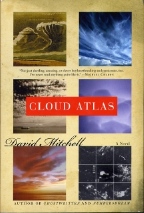 |
 David Mitchell
David Mitchell
Cloud Atlas
Reviewed by: Rick Kleffel © 2006
Random House
US Trade Paperback Original
ISBN 0-375-50725-6
Publication Date: 08-17-2004
509 Pages; $14.95
Date Reviewed: 04-12-06
Cloud Atlas
David Mitchell
Sceptre / Hodder and Stoughton
Country Format Edition: UK Trade Paperback
ISBN: 0-340-82278-3
Pages: 529 Price: £7.99
Hardcover Publication date: March 1, 2004
Index:
General Fiction
Science Fiction
Mystery
Fantasy
The invisible threads that connect us to one another and to the universe, the past to the present and the present to the future are what we weave together and perceive as our worlds, our lives. David Mitchell makes them visible in 'Cloud Atlas', itself a map of words and worlds. Mitchell's novel is complex and complete, engrossing and extravagant. Daring in concept and execution, it's the kind of novel that turns high-falutin' litrary critics into lovesick adolescents. It's almost impossible to greet the excesses of this novel without resorting to the critical equivalent.
Forget all the excesses, and punt the literary drooling. 'Cloud Atlas' is first and foremost GREAT READING. Entertaining characters in exceptional danger parade through the pages, speaking to the reader in voices that cannot be ignored. The clever concept that Mitchell uses to tell his tales is neither rocket science nor literary scholarship. It's gripping storytelling of the type that's been used since time immemorial. Mitchell knows how to write up a storm, and even if that storm stretches across hundreds, perhaps thousands of years, stories are stories. 'Cloud Atlas' is by any measure a great literary achievement. But first, measure it thusly. Start reading and you won't want to stop until the final word. You'll feel just as compelled to turn these pages, and they will turn just as easily, as if you were immersed in the latest series entry from your favorite genre-fiction writer.
One of the most common techniques used by today's writers is the jump-cut in a round robin of characters' perceptions. Each short chapter advances the action by some iota of plot and character, and each short passage leads seamlessly to the next. Mitchell's take on this technique is unique but no less effective. 'Cloud Atlas' jump-cuts between six characters' stories. The Mitchell-spin is that these characters are widely separated, and their stories seem at first rather disparate. Starting at the earliest chronological point in 1850, with "The Pacific Journal of Adam Ewing," Mitchell dispenses a good novella's worth of story for each of the six characters, moving through a variety of stories, characters and even literary genres, with two of the segments taking place in future settings that are not necessarily futuristic. It helps that each sub-story is told in tightly plotted bits. But he only offers half of each story until he reaches the center point, set in an indeterminate future on the island of Hawaii. Here the remains of civilization wait for the whimper; and here the story reverses and the stories started in the first half of the novel are completed in reverse. It's the kind of structure that might be far too clever if Mitchell didn't know how to grab and rivet the reader with a parade of powerful stories that are themselves part of a more powerful story.
Mitchell's characters are a great group of people to spend your time with. From the genial and slowly-going-mad Adam Ewing to the plain-spoken Sonmi-451, Mitchell creates voices that stand out in a crowd. He offers the reader a variety of prose styles and plot styles. One of the stories here is a riveting mystery set on the California coast in the 1970's, involving corporate greed and clandestine cover-ups. It's titled "Half Lives: The First Luisa Rey Mystery" and it's good enough to make you want to read the second Luisa Rey Mystery. Got that, Mr. Mitchell? We're waiting. Oh, we 're much more patient than the publishers would suspect.
Each sub-story quickly entices the reader with an attention-grabbing plot, and the tales are told by people who pop right off the pages and into your life. This is the kind of reading the hard-core readers absolutely delight in. Yes, I'll allow that it's not without challenges. But the challenges of reading 'Cloud Atlas' are so quickly and richly rewarded that they don’t merit much mention. The intricate literary stylings, and there are plenty of them, are easily subsumed by the involving stories. As soon as you meet each character, you can't help but want to find out their fate. This is a novel that is meant to be read, damn it, not dissected. Don't let the fact that it can be dissected dissuade you from the utter and complete enjoyment to be found here.
'Cloud Atlas' is the kind of novel that could launch ten thousand master's theses. I used up an entire stack of stickies taking notes about the various threads, and I have to admit that one of the great glories was seeing my early impressions and suspicions confirmed as the reading just kept coming. I will note that although one would have hoped that this particular masterpiece from Mitchell surely deserved a hardcover American edition, the economically priced trade paperback is nicely designed and rather a joy to read. Yes, really, all of that is down to David Mitchell's skills. And it’s not his literary skills so much as his people skills. This is a writer who knows that he's writing not for critics, not for the ages -- though both will be immensely pleased -- but for the people, the happy, happy people who get to sit down and pick up 'Cloud Atlas'. Prepare to read! Whee!
|
 |
